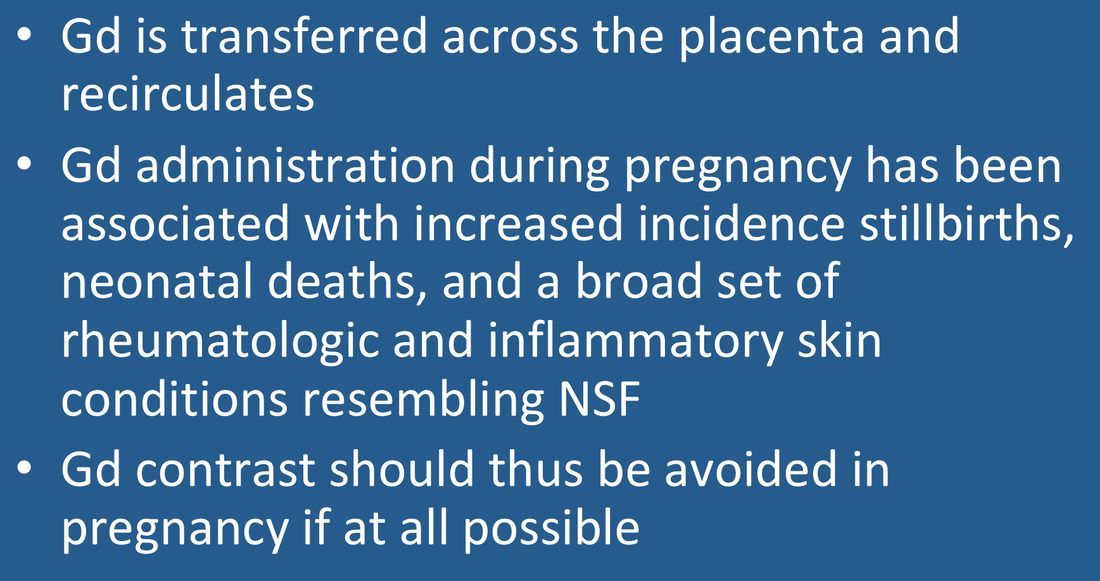Gadolinium contrast freely passes through the placenta, which by the second trimester receives 18-30% of the administered dose. The transferred gadolinium then passes into the fetal circulation where it is excreted into the urinary tract and subsequently into the amniotic fluid. Some of the gadolinium in the amniotic fluid will be reabsorbed by the maternal circulation, while some will be swallowed and reabsorbed through the fetal GI tract. A study by Oh et al. demonstrated only minimal amounts of gadolinium were detected in newborn monkeys shortly after maternal injection.
Fetal anomalies and intrauterine growth retardation have been reported in pregnant rats given high doses gadolinium contrast over prolonged periods of time, but this has not been confirmed on other studies. In the first controlled human study of MRI and gadolinium exposure in pregnancy performed by Ray et al in 2016, a slightly higher incidence of stillbirths and early neonatal deaths (but not congenital malformations) was observed in the gadolinium-exposed group. More worrisome, however, was an increased number of rheumatologic, inflammatory, and infiltrative skin conditions, including some resembling nephrogenic systemic fibrosis (NSF). However, a more recent study by Winterstein et al (2022), which was better controlled to remove confounding factors such as fetal anomalies and other indicational biases, did not observe any increased risk of fetal or neonatal death or increased intensive care admission in gadolinium-exposed fetuses. Less severe disorders (like inflammatory or infiltrative skin conditions) were not considered in this later study.
Out of caution, therefore, I believe gadolinium should be avoided in pregnant patients if at all possible, unless the perceived diagnostic value of information obtained exceeds these potential risks.
Advanced Discussion (show/hide)»
No supplementary material yet. Check back soon!
References
ACR Committee on Drugs and Contrast Agents. ACR Manual on Contrast Agents, 2024. American College of Radiology, 2024.
Oh KY, Roberts VHJ, Schabel MC, et al. Gadolinium chelate contrast material in pregnancy: fetal biodistribution in the nonhuman primate. Radiology 2015; 276:110-118. (Only minimal amounts of gadolinium were detected in 3rd trimester fetal monkeys 21 hours after maternal injection.)
Ray RG, Vermeulen MJ, Bharatha A, et al. Association between MRI exposure during pregnancy and fetal and childhood outcomes. JAMA J Amer Med Assoc 2016; 316:952-961. (Important recent controlled study evaluating outcomes of ~400 human pregnancies where gadolinium was administered).
Sundgren PC, Leander P. Is administration of gadolinium-based contrast media to pregnant women and small children justified? J Magn Reson Imaging 2011: 34:750-757.
Webb JAW. Thomsen HS, Morcos SK, et al. The use of iodinated and gadolinium media during pregnancy and lactation. Eur Radiol 2005; 15:1234-1240.
Winterstein AG, Thai TN, Nduaguba S, et al. Risk of fetal or neonatal death or neonatal intensive care unit admission associated with gadolinium magneticresonance imaging exposure during pregnancy. Am J Obstet Gynecol 2022; 1.e1-1.e11.
ACR Committee on Drugs and Contrast Agents. ACR Manual on Contrast Agents, 2024. American College of Radiology, 2024.
Oh KY, Roberts VHJ, Schabel MC, et al. Gadolinium chelate contrast material in pregnancy: fetal biodistribution in the nonhuman primate. Radiology 2015; 276:110-118. (Only minimal amounts of gadolinium were detected in 3rd trimester fetal monkeys 21 hours after maternal injection.)
Ray RG, Vermeulen MJ, Bharatha A, et al. Association between MRI exposure during pregnancy and fetal and childhood outcomes. JAMA J Amer Med Assoc 2016; 316:952-961. (Important recent controlled study evaluating outcomes of ~400 human pregnancies where gadolinium was administered).
Sundgren PC, Leander P. Is administration of gadolinium-based contrast media to pregnant women and small children justified? J Magn Reson Imaging 2011: 34:750-757.
Webb JAW. Thomsen HS, Morcos SK, et al. The use of iodinated and gadolinium media during pregnancy and lactation. Eur Radiol 2005; 15:1234-1240.
Winterstein AG, Thai TN, Nduaguba S, et al. Risk of fetal or neonatal death or neonatal intensive care unit admission associated with gadolinium magneticresonance imaging exposure during pregnancy. Am J Obstet Gynecol 2022; 1.e1-1.e11.
